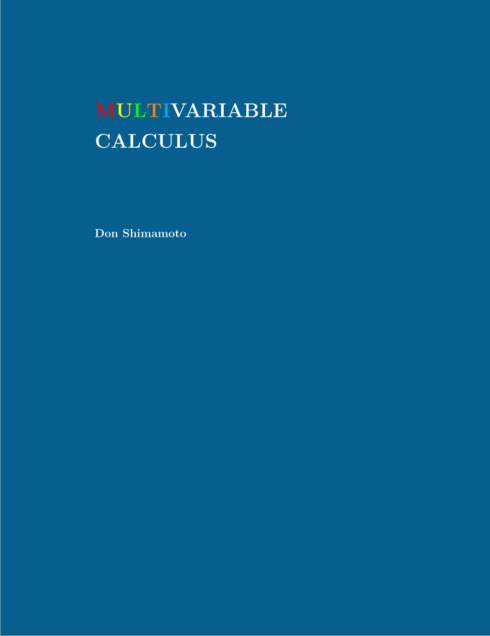
Multivariable Calculus
![]()
![]()
![]()
![]()
![]()
Don Shimamoto, Swarthmore College
Copyright Year: 2019
Last Update: 2020
Publisher: Don Shimamoto
Language: English
Formats Available
Conditions of Use
![]() Attribution
Attribution
CC BY
Reviews
Has all the usual topics and then some. I liked the development of differential forms towards the end and having chapter 11 as a teaser for higher level stuff. The development was clear enough that I hope most students at this level could get... read more
![]()
![]()
![]()
![]()
![]()
Has all the usual topics and then some. I liked the development of differential forms towards the end and having chapter 11 as a teaser for higher level stuff. The development was clear enough that I hope most students at this level could get it.
Some of my favorite examples were missing: e.g., the cycloid and deriving Kepler's laws from Newton's laws, but everybody has their own favorites so I am okay with that.
In discussing multivariable continuity, it would have been nice to pull out the two path discussion which appears in the text and highlight it as a theorem, but these are all minor points. I still give this text a 5 for comprehensiveness.
My only complaint here is in the discussion of torsion. He describes torsion as "wobbling" which to me gives the wrong idea. Wobbling means going back and forth which can happen in the plane. Torsion is "twisting" out of the plane.
The mathematics is all correct and the author is honest about where things are being swept under the rug, e.g., in the proof of Green's Theorem.
This is not much of an issue for math texts.
Excellent! Good clear explanations of the ideas behind the theory, e.g., Lagrange multipliers which are sometimes presented as magic, but here are motivated with geometrical ideas. Nice treatment of multidimensional chain rule via matrix multiplication with one section on the conceptual picture and one on computations.
Good diagrams throughout, present whenever needed to help with understanding, e.g., showing the relationship of two different parametrizations when proving that the value of the integral is independent of the parametrization.
No problems that I saw.
The division into parts, chapters, and sections made sense and the sections were not too long.
Good. The preface and table of contents outline the organization and make it easy to find topics.
It might be helpful to introduce polar coordinates earlier.
No problems that I saw. It easy to navigate jumping around with the bookmarks pane in Adobe. Good color illustrations showing geometric pictures when helpful.
Fine.
Not really relevant.
I really liked this text. It is more theoretical, more proof-based than what I usually teach, and I might skip some of that if I were teaching from this text, but I think it is good to include the proofs in the text.
I liked the presentation of differential forms towards the end. I think one addition to chapter 11 as a further teaser and to try to show the relationship of the various theorems, would be to set up the deRham sequence in R^3 and show how gradient, curl, and divergence come into that single unifying sequence. (This tiptoes up to topology of the underlying space which the author has already alluded to at various places.)
The conversational style was great: "trying to find the maximum of a function like ... is silly" for example. Humor is scattered throughout, for example, including a picture of a porcupine as an example of a mammal with an orientation.
There seemed to be plentiful exercises.
Overall, I think this is an excellent text for multivariable calculus.
Table of Contents
- I Preliminaries
- 1 Rn
- II Vector-valued functions of one variable
- 2 Paths and curves
- III Real-valued functions
- 3 Real-valued functions: preliminaries
- 4 Real-valued functions: differentiation
- 5 Real-valued functions: integration
- IV Vector-valued functions
- 6 Differentiability and the chain rule
- 7 Change of variables
- V Integrals of vector fields
- 8 Vector fields
- 9 Line integrals
- 10 Surface integrals
- 11 Working with differential forms
Ancillary Material
Submit ancillary resourceAbout the Book
This book covers the standard material for a one-semester course in multivariable calculus. The topics include curves, differentiability and partial derivatives, multiple integrals, vector fields, line and surface integrals, and the theorems of Green, Stokes, and Gauss. Roughly speaking the book is organized into three main parts corresponding to the type of function being studied: vector-valued functions of one variable, real-valued functions of many variables, and finally the general case of vector-valued functions of many variables. As is always the case, the most productive way for students to learn is by doing problems, and the book is written to get to the exercises as quickly as possible. The presentation is geared towards students who enjoy learning mathematics for its own sake. As a result, there is a priority placed on understanding why things are true and a recognition that, when details are sketched or omitted, that should be acknowledged. Otherwise the level of rigor is fairly normal. Matrices are introduced and used freely. Prior experience with linear algebra is helpful, but not required.
About the Contributors
Author
Don Shimamoto, Swarthmore College
